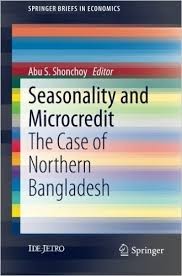This volume uniquely addresses the mismatch between credit repayments and income seasonality, which can create serious distortions. Typically, Micro-Finance Institutes (MFIs) do not provide any adjustments due to the income seasonality. For instance, in Northern Bangladesh, income and consumption downfalls during the time of post-Aman rice plantation season are a regular phenomenon, locally known as “Monga”. Poor landless agricultural wage laborers suffer the most due to this seasonality and usually face difficulty to smooth their consumptions. As a result, it is extremely difficult to arrange the regular weekly loan repayments of the micro-credit, which they have initiated during the productive part of the year. The reluctance of the MFIs to provide any flexibility or seasonal adjustments during the period of Monga is mainly for two reasons; 1) it might break the loan collection disciplines and 2) it might increase the loan defaults. Using field experiments through RCTs in Northern Bangladesh the authors randomly assigned seasonality-adjusted flexible micro-credit and traditional rigid micro-credit to different borrowing groups. The results suggest no statistically discernible differences among the treatment arms in case of default, repayment frequency or overdue amount, which is in favor of flexible design of micro-credit. However, they did not find any impact of flexible micro-credit on short-term seasonal migration during the lean season as well as no positive impact of the repayment flexibility on food consumption during the lean season.
SEASONALITY AND MICROCREDIT: THE CASE OF NORTHERN BANGLADESH

-
March 12, 2014